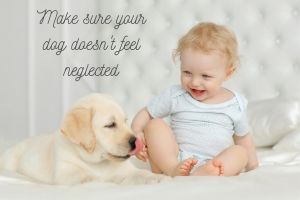For many expectant parents, their first baby was a fur baby. Your dog has gotten used to having all of Mom's and Dad’s attention, and a shift in that attention can mean stress for everyone. Even before the human baby arrives, your dog will sense change is coming, from the physical changes to Mom to changes around the house such as new furniture and strange new baby paraphernalia. Your pup can even sense the excitement and nervousness you may be feeling. The key to having your dog welcome the baby as its new best friend is in the preparation. By planning ahead and giving your dog time to adjust, your pooch will feel more comfortable and at ease with this major life change. Here’s what you need to know if you’re expecting a baby.
Preparing For Your Dog to Meet Your Baby
You have about 9 months to prepare your dog; look at this time that you spend waiting for your baby’s arrival as an investment in your peace of mind later. A drastic change in the amount of time you spend with your dog can cause jealousy and depression, which can lead to behavioral problems. Weaning your dog away from undivided attention slowly can help them adapt more easily once the baby is home. If your dog is used to curling up in your lap, then start getting your pup used to laying beside you, or offer it a cozy bed on the floor by your feet.

What Kind of Training Should I Do With My Dog Prior to the Baby Arriving?
Train your dog that it may only hop onto your lap at your invitation. If your dog sleeps in bed with you, you’ll have to decide now if that’s going to continue once the baby comes. Don’t wait until after the baby arrives to banish the dog from the bed. Does your dog know basic obedience training? If so, great! Begin reviewing those skills daily so that your dog will consistently obey you when you tell him or her to sit, stay, or lay down. If your dog doesn’t know those commands, now is the time to enroll in a class. Does your dog jump on you while you’re standing? Curb that unwanted habit now before your dog is jumping on you with a baby in your arms, or jumping on a toddler down the road.
What Should My Vet Do to Help Me Prepare for My Dog Meeting Baby?
Make sure your dog has a wellness exam and is current on vaccines. If your pet isn’t already spayed or neutered, now is the time to do so, as this can help calm possible aggression and other behavioral issues. If your pet is already displaying anxiety, please discuss this with your veterinarian. Our veterinarians can manage many cases of anxiety through routine appointments. Behavior problems range from relatively simple to more complex. Multiple appointments may be necessary to address more complex issues (or multiple issues). For the most complicated cases - which would include cases involving dogs that have a history of aggression and that will remain in a household with children, particularly young ones - we can provide you with a reference to a board-certified veterinary behaviorist who can help.
What Should I Do Around My House Dog Meeting Baby?
Find recordings of a baby crying and cooing on YouTube and play these throughout the day to get your dog used to sounds a baby makes. If you plan to have moving baby swings or baby items that make noise, start using them now. Make all of these sessions positive experiences by offering your dog a treat or other form of reward. Set up the baby’s room slowly and well in advance of the baby’s arrival so that this isn’t a drastic change in the home. This is the time to establish boundaries. Will your dog be allowed in the room? If so, let your dog inspect it. If not, install a baby gate now. A gate will allow your dog to see inside and not feel left out of all the fun. This is a great time to install any baby gates that will be needed later and put them into use so that they don’t suddenly become a “prison” when the baby comes.
Remember to keep dirty diapers in a pet-proof bin. And soiled baby clothes with milk or spilled food on them can be irresistible to pets, so a pet-proof laundry hamper is a good idea, too.
What to Do as the Due Date Approaches
Many expectant parents have found success in preparing their dog for the arrival of a new baby by getting a life-sized, realistic doll and treating it as they would a real baby. Wrap it in a blanket, hold it, coo to it, carry it from room to room, diaper it, and have it use the baby swing, bassinet, and crib. Teach your dog to sit and stay whenever it is around the “baby” and only allow it to investigate the doll if your dog can remain calm. Reward your pup for good behavior with treats, praises, and a good petting, so that interacting with the baby will become a positive experience. Reinforcing good behavior prompts your dog to repeat that behavior.
What is Stroller Conditioning?
Practice walking your dog with the stroller if walking together is something you plan to do later. The stroller is typically the most likely piece of equipment that dogs react to with anxiety or even aggression. Stroller conditioning should begin many months ahead of time to associate it with good things: walks, treats, and attention—but only when you dog is exhibiting calm behavior.
Bringing Baby Home
While you’re still in the hospital, have a friend or family member bring home an article of clothing or blanket that the baby has used for the dog to smell—but don’t allow the dog to take it from that person. Once you actually bring the baby home, your dog will already be familiar with the baby's scent. When walking in the door, try to remain as calm as possible, and have someone other than Mom carry the baby inside so that she can be free to say hello to the dog. Much like with human siblings, offering the dog a new toy can help keep the homecoming positive.
How to Delicately Approach Dog Meeting Baby
Some may find the following section a bit controversial, but a simple Google search will result in articles that suggest nearly the same advice for introducing your dog to your baby. Keep the first introduction between dog and baby short, and have someone else hold the dog or leash while Mom holds the baby.
If the dog is too excited, have the person back up, wait a few moments for the dog to calm down, and try again. The dog should only be allowed to investigate the baby if the dog remains calm. Never force an interaction between the dog and the baby; this new wriggling creature may take some getting used to! Keep treats within easy reach the first few days after the baby comes home and remember to give praise and a reward anytime your pup is staying calm when the baby is nearby. In this way, your dog will come to associate the baby with good things!
Even if you couldn’t have imagined a better introduction and the two of them seem like instant best friends, supervise their interactions 100 percent of the time. Accidents happen and even non-aggressive play can be dangerous for a baby. However, our recommendation is to not allow direct contact between the dog and the baby. They can be in the same room, assuming they are not exhibiting concerning behaviors. Newborn babies have many movements and sounds that can elicit predatory instincts in some dogs. This is not always predictable, is often hard to recognize (as dogs with predatory aggression seem eager to investigate the baby, and attacks are often silent), and is typically the underlying cause of fatal attacks of dogs on babies.
When Can I Allow Direct Interaction Between Dog and Baby?
There is really no need for a dog to have direct interaction with a baby. The time for direct-contact introductions should be delayed at least until the toddler stage, when children become more mobile and often pose greater concern to dogs (who can find toddlers' unpredictable behavior frightening). Any introductions then should be made only with dogs that have shown calm behavior around the child, with direct supervision and with two adults present. Dog bites can do a great deal more damage than most people realize.
Are There Any Helpful Resources For Dogs Meeting Babies?
We highly recommend you review the Liam J. Perk Foundation website, which provides awareness and education on dog bites and children. Their Facebook page is an excellent resource on learning the behaviors we might miss when a dog is feeling anxious, fearful, or aggressive. The Blue Dog also strives to educate parents on safer relationships between children and dogs. According to their website, "Because most accidents with family dogs result from seemingly benign (from the human perspective) interactions, the aim of The Blue Dog is to stimulate awareness in parents about how their dog behaves when hugged, petted, or approached in different situations."
Settling into Life After Baby
Your time is without a doubt now divided between your fur baby and his or her new “sibling". Some dogs will naturally adapt to this change, while others may become destructive as a way to get attention, while others may become overly protective of its new human. Still other dogs may exhibit anxiety by urinating in the baby's room or on the baby's clothes, toys, or other items. This isn't necessarily an act of jealousy, or a means to get back at you or the baby. Territorial marking can relieve your dog's stress by covering the baby's scent with his or her own. As tempting as it may be to scold your dog for this, it could actually make the anxiety worse during this adjustment period. Instead, block access to the baby’s room or other urination targets, and find a way to spend more time with your pup.

How Can I Keep My Dog Out of Trouble During the Dog-Meeting-Baby Phase?
Don’t forget how important exercise is for a dog to display good behavior. If your dog has unreleased energy, then raiding the garbage and other shenanigans can ensue. Arrange for your dog to get a long walk each day, or some time for his or her favorite game in the backyard. If your dog is still getting in more trouble than usual, redirect the behavior to a chew toy so that your pup isn’t always getting scolded.
Make sure that when you talk to your baby, you talk to your pooch, too, so that the interaction between the two is pleasant. For those times that you need to confine your dog to an area away from the baby, your dog should already be used to time behind a baby gate. He or she can even learn to enjoy this time if they are given a special chew or a treat stuffed toy to occupy themselves.
By taking the time to prepare your dog for your baby’s arrival, you can help ensure that the two will go from strangers to lifelong friends. If you’re worried about juggling a new baby and your dog in the early days, consider signing up your dog for daycare. You’ll have time to bond with your baby, and your dog will have a blast getting out all that pent up energy!

